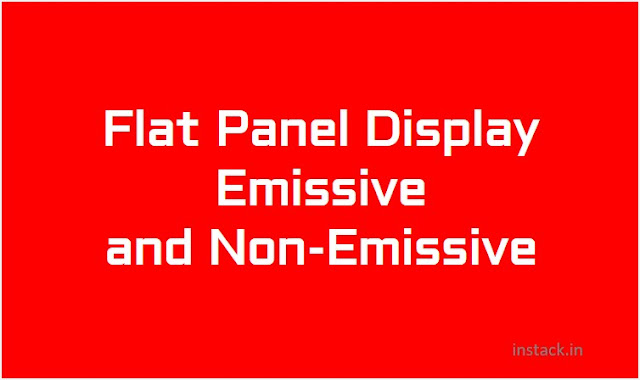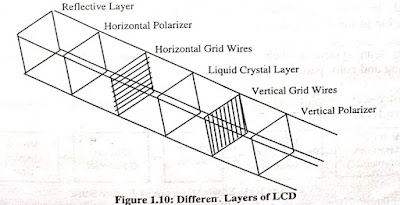Flat Panel Display | Emissive and Non-Emissive
As CRT
and DVST have large volume, and weight and require large power consumption they are
outdated devices and are replaced by Flat Panel Derives.
Types of Flat Panel Display Devices
Flat
Panel Display
·
Emissive Display Devices
o Plasma Panel
Devices
·
Non-Emissive Devices Display
o Liquid Crystal Display
Emissive Display Devices
These
devices work by converting electric energy into light. The various devices are
plasma panels, light-emitting diodes. A major example of a flat panel display
is the plasma panel display.
Plasma Panel Display
It is a
device in which each pixel remains bright after it has been intensified. It is
very similar to DVST though its construction is very difficult. Plasma pan
display writes images on the display surface point by point, each point remains
bright after it has been intensified. This makes the plasma panel functionally
very similar to the DVST even though its construction is markedly different.
Figure 1.9 shows the construction of the plasma panel display. It consists of two
plates of glass with thin, closely spaced gold electrodes. The gold electrodes
are attached to the inner faces and covered with a dielectric material. These
are attached as a series of vertical conducting ribbons on one glass plate, and
a set of horizontal ribbons to the other glass plate.
The
space between two glass plates is filled with neon-based gas and sealed. By
applying voltages between the electrodes the gas within the panel is made to
behave as if it were divided into tiny cells, each one independent of its
neighbors. These independent cells are made to glow by placing a firing voltage
of about 120 volts across it by means of the electrodes. The glow can be
sustained by maintaining a high-frequency alternating voltage of about 90 volts
across the cell. Due to this refreshing is not required.
Construction of Plasma Panel Display
The plasma panel display consists of two thin glass sheets with gold electrodes arranged
horizontal and vertical on the corresponding glass sheets. The region between
the glass plates is filled with a Neon gas.
By
applying voltage the gas within the cell breaks down into electrons and ions
and the glow starts. Once the glow starts, the voltage can be decreased up to which
glow continues.
Advantages of Plasma Panel Display
1) It
produces a steady image, totally free of flickers.
2) Requires
small space.
3)
Requires low voltage and power supply.
Disadvantages of Plasma Panel Display
1) It
has low resolution
2) It
is very costly.
Non-Emissive Display Devices
These
devices work by using optical effects to convert sunlight or light from some
other source into graphics patterns. Liquid crystal is the most common example
of a non-emissive flat panel display device. A major example of a flat panel
display is the liquid crystal display.
Liquid Crystal Display (LCD)
It is a
non-emissive device that produces a picture by passing polarized light through
a liquid–crystal material that can be aligned to either block or transmit the
light. LCD is given a name so, because the compound filled between the glass
plates is a crystalline arrangement of molecules, hence they flow like a
liquid.
Construction of Liquid Crystal Display
It
consists of two glass plates, each containing a light polarizer at right angles
to the other plates, with threadlike liquid crystal filled in between. The
Molecules of Nematic are arranged such that polarized light passing through the
material is twisted so that it will pass through the opposites polarized. The
light is then reflected back to the viewer. To turn off the pixel, one applies
voltage to the interacting conductors to align the molecules so that the light
is not twisted. The different layers of LCD are shown in figure 1.10.
Advantages of LCD
1) Very
compact and light.
2) Low
power consumption.
3) No
geometric distortion.
4)
Little or no flicker depending on backlight technology.
5) Not
affected by screen burn-in.
6) Can
be made in almost any size or shape.
7) No
theoretical resolution limit.
Disadvantages of LCD
1)
Limited viewing angle, causing color, saturation, contrast, and brightness to
vary, even within the intended viewing angle, by variations in posture.
2)
Bleeding and uneven backlighting in some monitors, causing brightness
distortion, especially toward the edges.
3)
Smearing and ghosting artifacts caused by slow response times (>8ms) and
“sample and hold” operation.
4) Only
one native resolution. Displaying resolutions either requires a video scaler,
lowering perceptual quality, or display at 1:1 pixel mapping, in which images
will be physically too large or would not fill the whole screen.
5) Low
bit depth results in images with unnatural or excessive contrast.
6) Dead
or stuck pixels may occur during the manufacturing or through use.
7) Not
all LCDs are designed to allow easy replacement of the backlight.
8)
Cannot be used with light guns/pens.
9) Loss
of contrast in high-temperature environments.







